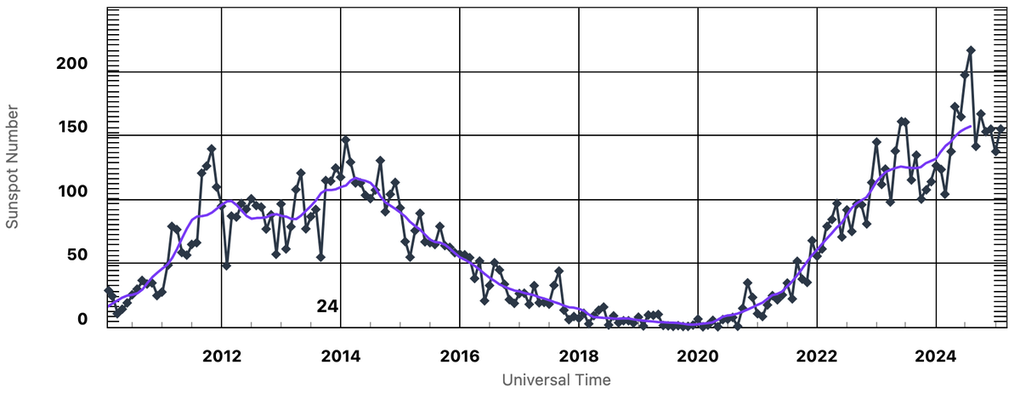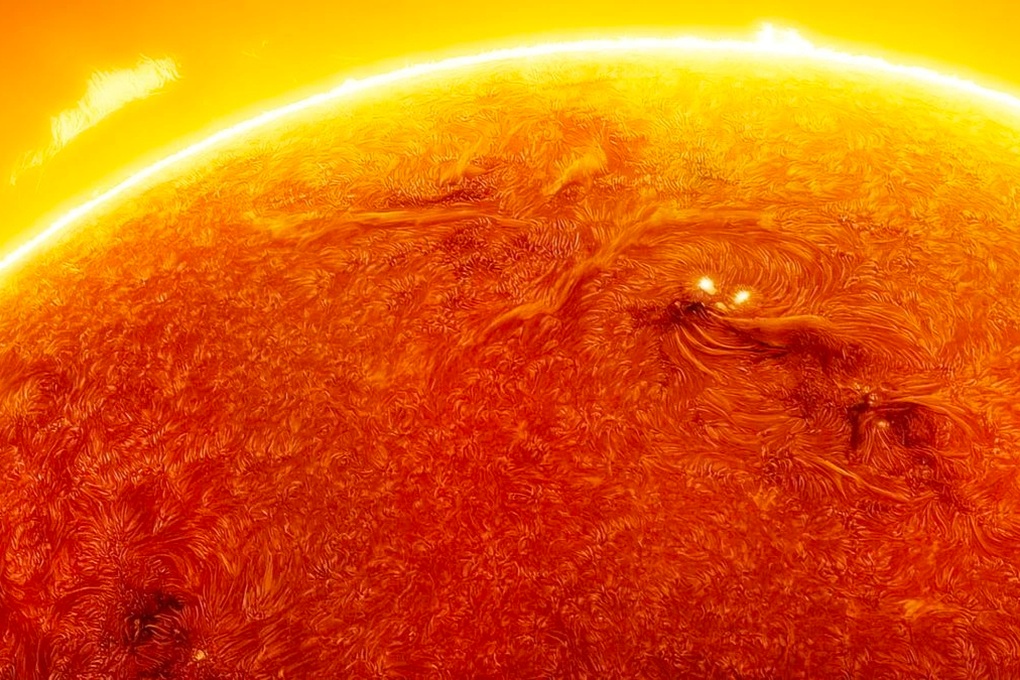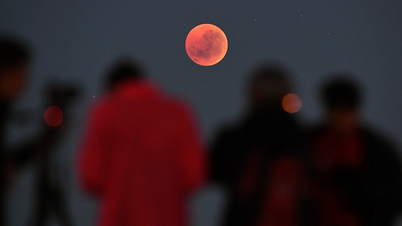(Dan Tri) - The Sun is entering the most active phase of its 11-year cycle, known as solar maximum. However, the question is: Are we still in this phase, or has it passed?
Beyond scientific prediction

The number of sunspots recorded by NOAA from 2010 to present shows the evolution of solar cycles 24 and 25 (Photo: NOAA).
To answer this question, we must first understand that the Sun is not a static celestial body. Therefore, there are always many powerful activities taking place on the Sun, including phenomena such as flares, eruptions of matter and changes in the magnetic field.
There, concentrated magnetic fields create a series of sunspots, which form outbreaks known as coronal mass ejections (CMEs).
These phenomena have a significant impact on space weather, which can affect Earth. Solar activity varies in an 11-year cycle, oscillating from minimum to maximum. During minimum, there may be consecutive months with no sunspots. At maximum, the number of sunspots, solar flares, and CMEs increases significantly.
Since Solar Cycle 25 began in December 2019, scientists have been closely monitoring solar activity.
Initial predictions from NOAA's Space Weather Prediction Center indicate that solar maximum could occur in July with sunspot counts ranging from 101.8 to 125.2 per month.
However, the reality has far exceeded scientists' predictions. In August 2024, the smoothed sunspot count, based on a 13-month average, reached 156.7 - much higher than originally predicted. And the number has continued to rise. This raises the question: Has the solar maximum passed?
"Double maximum" and many unexpected variables

Scientists warn that a double solar maximum could occur in July with many violent outbreaks (Photo: Getty).
According to the August 2024 sunspot count chart, the number of sunspots peaked at 216. From then until March, the number fluctuated between 136 and 166 each month, indicating a slight decrease in activity.
Some experts believe that solar maximum will pass sometime between August and November 2024. However, this prediction is not yet entirely certain.
History shows that some previous solar cycles have had double maximums. Solar Cycle 24, for example, had two peaks, occurring in 2012 and 2014. If Solar Cycle 25 follows a similar pattern, it is possible that the solar maximum will not be over yet, but will last until the end of 2025.
As mentioned, periods of intense solar activity are often accompanied by important phenomena such as solar flares and CMEs. Solar flares release large amounts of radiation and high-energy particles, which can cause radio interference on Earth.
Meanwhile, CMEs are massive ejections of plasma from the solar corona into interplanetary space, sometimes directly toward Earth. When these plasma masses collide with Earth’s magnetosphere, they can trigger powerful geomagnetic storms that affect power grids, satellites, GPS systems, and even human health due to the increased cosmic radiation.
In addition, strong solar activity also affects the Earth's ionosphere, causing loss of HF radio signals, affecting aviation and military communications.
In particular, increased geomagnetic storm intensity can reduce Earth's natural protection from solar radiation, creating effects such as brilliant auroras at lower latitudes than usual. Scientists have also observed that solar maximum can contribute to temporary climate changes due to the overall increase in radiation from the Sun.
Even though solar maximum has passed, that doesn’t mean solar activity will immediately decline. In fact, sunspots, CMEs, and geomagnetic storms can still be very active for the next year or two.
This could combine with global warming, and continue to affect the Earth in different ways.
Source: https://dantri.com.vn/khoa-hoc/mat-troi-co-the-dat-cuc-dai-kep-chuc-cho-bung-no-vao-thang-7-20250328115350678.htm


![[Photo] Solemn opening of the 8th Congress of the Central Public Security Party Committee, term 2025-2030](https://vphoto.vietnam.vn/thumb/1200x675/vietnam/resource/IMAGE/2025/10/4/f3b00fb779f44979809441a4dac5c7df)
![[Photo] General Secretary To Lam attends the 8th Congress of the Central Public Security Party Committee](https://vphoto.vietnam.vn/thumb/1200x675/vietnam/resource/IMAGE/2025/10/4/79fadf490f674dc483794f2d955f6045)



![[Photo] Bustling Mid-Autumn Festival at the Museum of Ethnology](https://vphoto.vietnam.vn/thumb/1200x675/vietnam/resource/IMAGE/2025/10/4/da8d5927734d4ca58e3eced14bc435a3)
























































![[VIDEO] Summary of Petrovietnam's 50th Anniversary Ceremony](https://vphoto.vietnam.vn/thumb/402x226/vietnam/resource/IMAGE/2025/10/4/abe133bdb8114793a16d4fe3e5bd0f12)
![[VIDEO] GENERAL SECRETARY TO LAM AWARDS PETROVIETNAM 8 GOLDEN WORDS: "PIONEER - EXCELLENT - SUSTAINABLE - GLOBAL"](https://vphoto.vietnam.vn/thumb/402x226/vietnam/resource/IMAGE/2025/7/23/c2fdb48863e846cfa9fb8e6ea9cf44e7)
































Comment (0)